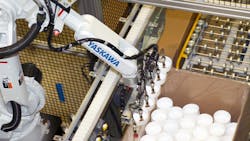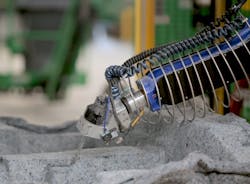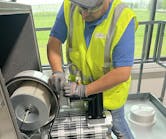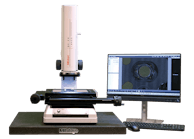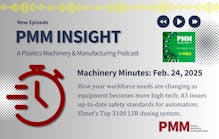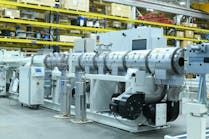How, and why, to fit automation into a plastics processing facility
By Bruce Geiselman
Demand for plant automation has increased as the world emerges from the COVID-19 pandemic and employers struggle to find workers.
“I’ve seen a significant increase in demand post-COVID,” said Todd A. Bauernfeind, president of Summit Engineered Automation since 1999. “Obviously, when COVID hit, everything hit the fan, so to speak. But as we start to come out of that, we see high employment numbers. We see our customers struggling to hire enough people, which is pushing them toward looking at what tasks they can automate.”
Employers, including plastics processors, just can’t find the people to do the tasks they need to have done, he said. In plastics processing, that often means injection molders are looking to automate assembly of components into a finished product.
Plastics processors can run into complications when trying to automate tasks previously done by workers, said Kyosuke Nakamura, a key account manager with Yaskawa Motoman Robotics.
“It becomes a floor-space issue,” Nakamura said. “Automating it, obviously, will take up more floor space than manual labor. People have been basically automating since COVID started, and they are running out of floor space.”
Solutions could include minimizing the footprint of production cells or finding automation solutions that require less space.
Industrial robots often used for machine tending and post-processing tasks, like inspection and assembly, may require considerable floor space because of safety fencing to protect workers. Using collaborative robots (cobots) that don’t require fencing is one possible solution to maximize floor space. However, cobots can’t do everything.
“The cobot has been doing a great job, but it is limited as to what it can do,” Nakamura said. “It, obviously, cannot hold onto a knife or a nipper or anything like that that would cause harm to a human being.”
Speed is another limitation, Nakamura said. Robots moving at high speeds pose a risk to humans working nearby.
“Obviously, you can’t have them bump into an operator next to them and hurt them,” Nakamura said. “That means they’re going to have to move slower than normal industrial robots.”
However, cobots could be an excellent fit for assembly or packaging tasks, he said.
A second potential complication when adding automation is ceiling height. This is particularly an issue when adding a gantry robot for mold tending.
“Ceiling heights become an issue with gantries because they fit on top of the injection molding press,” Nakamura said.
When determining the amount of ceiling height required, it’s important to consider what size injection molding machine the robot will tend.
“Having a 100-ton injection molding machine versus a 300-ton machine is a different story,” Nakamura said. “You’re going to have your height of the machine, and if you’re going to have a gantry on top of it, then you’re going to have to calculate at that height. Then you also have to have crane clearance for pulling out molds or whatever you need the crane for in the bay.”
One possible solution to inadequate ceiling height is creating a pit to install an injection molding machine below the normal floor level.
“I understand that is not cheap,” Nakamura said.
Robot manufacturers, like Yaskawa, and automation integrators often are able to help plastics processors calculate space requirements and figure out solutions for limited floor space and inadequate ceiling heights.
Automation can provide value-added services
Automation not only provides plastics processors with a solution for labor shortages, but it can help them add more services.
Over the past 10 years, Bauernfeind has seen a trend of plastics processors providing not only injection molded parts for customers, but increasingly they have begun assembling those parts into products.
“I’ve run into many more companies over the last 10 years that are not just molding the parts, but they are molding four parts and doing an assembly and shipping their customer a finished product rather than just shipped parts,” Bauernfeind said.
A lot of companies can just “shoot and ship” parts, but injection molders can add value to their services if they offer assembly as well, he said.
“You can usually find somebody else that will sign up for it cheaper, but you add a level of value, using your intelligence, when you get into putting components together,” Bauernfeind said. “Everybody’s material cost is the same, but if you take four parts and do an assembly, you increase your margin significantly. It’s just that not everybody can do that.”
Today’s workforce is better prepared for automation
Summit Engineered Automation has been in business for 25 years, and has seen a significant change in attitudes toward automation during those years.
“Twenty years ago, plants weren’t ready for robots because they didn’t have the support staff to support stuff like that,” Bauernfeind said. “But that has really changed as the next generation has entered the workforce and is computer-savvy. We’re implementing robots almost in all of our solutions, and we do a fair amount with plastic injection molders.”
Bauernfeind recommended that parts manufacturers do a better job of designing parts not only for manufacturability but also for automation.
“I don’t believe that near enough companies take that into consideration while they’re designing their product,” Bauernfeind said. “They’re worried about their product and its function and not necessarily worried about what it takes to put it together, and then they end up having a lot of challenges in getting it automated. You need to look at the big picture, right from the get-go: I’m going to design this for manufacturability and automation.”
Another factor manufacturers need to consider is that automation likes consistency, Bauernfeind said.
“It’s much easier to automate something if the parts coming in are of consistent quality,” he said.
Bauernfeind cited a typical practice among injection molders of opening a mold and allowing parts to drop into a box. That practice can result in part inconsistency that can complicate automated assembly processes.
“Oftentimes, we will make suggestions,” Bauernfeind said. “We’d like to see a gantry robot on that press removing the parts and putting them on a cooling conveyor. If you’re putting parts in a box, the warm ones at the bottom will have more pressure [on them] than the ones at the top, and it can distort or deform the parts slightly. In automation, that’s not a good thing.”
Bruce Geiselman, senior staff reporter
Contact:
Summit Engineered Automation, Shoreview, Minn., 651-371-9525, www.summitengineeredautomation.com
Yaskawa America Inc., Motoman Robotics Division, Miamisburg, Ohio, 937-847-6200, www.motoman.com
Automation webinar
Todd Bauernfeind of Summit Engineered Automation is one of the speakers on PMM's webinar on implementing good automation practices in your plant, along with Mike Gunner, VP automation, KraussMaffei. The webinar is sponsored by Lorenz Conveying Products. Watch it at plasticsmachinerymanufacturing.com/53060589/.
Bruce Geiselman | Senior Staff Reporter
Senior Staff Reporter Bruce Geiselman covers extrusion, blow molding, additive manufacturing, automation and end markets including automotive and packaging. He also writes features, including In Other Words and Problem Solved, for Plastics Machinery & Manufacturing, Plastics Recycling and The Journal of Blow Molding. He has extensive experience in daily and magazine journalism.
ABB appoints chief sales officer for B&R
KraussMaffei now building extruders in U.S.

